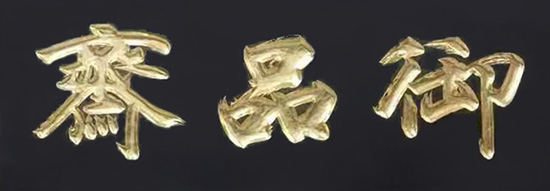
Plaques are artistic works that blend high-end calligraphy art and exquisite carving techniques in ancient Chinese architecture, complementing the magnificent architecture and becoming an important part of the finishing touch in architecture.
The plaques and plaques emphasize the artistic conception and literary style of the content, focusing on the values and aesthetic views of ancient Chinese culture. Like the "Returning to Our Rivers and Mountains" plaque in the Yuewang Temple and the "Sea Blue Sky" plaque in Hairui. For commendation plaques for martyrs, virtuous women, and families of officials, for plaques that adhere to ethical and political norms, as well as for plaques that warn and admonish, and for plaques that reflect on the origin of drinking water. Officials encourage themselves to have clear aspirations, such as plaques that read "a clear mirror hanging high", "fair and honest", and "discerning the slightest detail".
A considerable number of plaques are used by the owners of houses and study to express their aspirations and embellish their beauty. The common plaques in the entrance halls of traditional Chinese houses reflect the family background, ancestral virtues and achievements, family origins, ancestral teachings and family traditions, spiritual pursuits, and so on. At the entrance, hall, or building, there are plaques related to the surname and hall number hanging.
According to etiquette and customs, people also commonly use plaques for communication in interpersonal communication, such as the "Longevity in the South Mountain" plaque, the "Eternal Day in Huatang" plaque after building a house, and the sub theme "Wenqu Xingyao" plaque. Merchants have commercial plaques that symbolize "good luck", "prosperous business", "abundant financial resources", etc. Scenic spots and garden relics often have plaques that praise the grandeur of mountains and rivers, demonstrating the role of plaques in beautifying scenic spots.
The culture of plaques was severely impacted during the Cultural Revolution, and many plaques in many places were treated as "four old" and severely damaged, resulting in a stagnation of plaques culture for a considerable period of time. Until the reform and opening up, with the improvement of living standards and the pursuit of traditional culture, plaque culture has gradually regained people's attention in recent years. Many places restore or add plaques when repairing ancestral houses and ancestral temples, and add plaques when building new houses. Plaques are also set up in tourist attractions and newly built gardens, and some shops hang plaques inscribed by celebrities. The plaque culture is in the stage of restoration and development.
Hou Xuanhuan, from Wanxia Village, Sanjiao Town, Meijiang District, Meizhou City. He is the 24th generation descendant of the historical and cultural ancestor Hou Anguo in Meizhou. Member and director of the Chinese Calligraphers Association. Enjoying special allowances from the State Council, his works are collected by the National Museum of China.
He practiced calligraphy with his father at the age of seven and, through decades of dedicated research, developed an elegant and handsome calligraphy art style. His works have won numerous awards in national competitions. At this stage of cultural restoration and development on this plaque. Hou Xuanhuan strives to implement the cultural restoration and inheritance of plaques, and the plaques he writes and produces have the ancient charm of Ming and Qing dynasties, which is highly respected by industry insiders and various sectors of society.
To promote the culture of plaques, he utilized his strong calligraphy skills to create a batch of mahogany gilded plaques and couplets with dignified, heavy, and round fonts suitable for inscribing plaques. With a dignified and dignified high-end taste, he received praise from all walks of life. To further promote traditional plaque culture, a high-end rosewood plaque was created and written in the "Yupinzhai" to meet people's growing pursuit of traditional culture.
The plaque written and produced by Mr. Hou Xuanhuan has reached the level of famous plaques from the Ming and Qing dynasties, effectively inheriting the charm of classical plaques. Therefore, we hereby declare to the relevant departments as the inheritor of the intangible heritage of the plaque.















